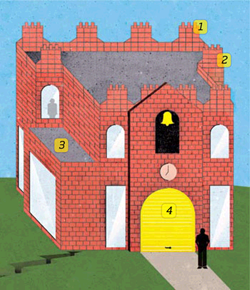In an earthquake, Tom Miller knows which buildings to avoid. When the shaking starts, you won’t find him standing next to an unreinforced masonry (brick) structure. The Oregon State University engineering professor’s 2006 survey of 1,075 public buildings in Western Oregon ranked them among the most likely to collapse.
To evaluate buildings for seismic risk, Miller led a student team that followed guidelines from the Federal Emergency Management Agency (FEMA 154). He worked with Portland State and University of Oregon students and faculty as well. During their field survey, they looked for design features that create “falling hazards” or that predispose a building to major damage.
Funded by the state’s go-to agency for seismic safety, the Oregon Department of Geology and Mineral Industries (DOGAMI), the study paved the way for additional engineering analysis and the state Legislature’s $30 million investment in renovations to schools, fire stations and hospitals in 2009. At OSU, Miller teaches courses in structural analysis and design.
“Professor Miller was a superstar in his significant contributions to the 2007 DOGAMI report,” says Yumei Wang, geohazards team leader for the agency. Miller received the 2010 Government Engineer of the Year Award from the Oregon section of the American Society of Civil Engineers.
Vulnerable Design Elements (see corresponding numbers on the illustration):
 1. Falling hazards such as parapets, unreinforced masonry chimneys and ornamentation/wall panels that are not adequately anchored to the frame. One telltale sign for unreinforced masonry (URM) walls: repeated brick layers placed with the narrow ends facing the outside of the wall. Spaced vertically every sixth or seventh row, such layers connect interior and exterior bricks that can peel away from the structure onto streets and sidewalks in an earthquake
1. Falling hazards such as parapets, unreinforced masonry chimneys and ornamentation/wall panels that are not adequately anchored to the frame. One telltale sign for unreinforced masonry (URM) walls: repeated brick layers placed with the narrow ends facing the outside of the wall. Spaced vertically every sixth or seventh row, such layers connect interior and exterior bricks that can peel away from the structure onto streets and sidewalks in an earthquake
2. Building designs that do not follow a simple rectangular shape. Such irregularities include L-shaped, T-shaped, and U-shaped variations. In an earthquake, each part of the building can move independently, and areas where sections join tend to concentrate stresses. As a result, they can crack and separate.
3. Vertical irregularities where a building becomes narrower as it rises. Seismic shaking again produces concentrated stresses at the step in elevation.
4. Buildings with large openings such as glass storefronts or garage-door openings for trucks. This very flexible wall can cause the building to twist and threaten the integrity of the entire structure.
5. The full seismic survey report is available online at http://www.oregongeology.org/sub/projects/rvs/default.htm.
